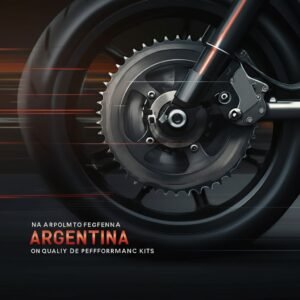Introduction
Sprockets are one of the most important components of your bike, as they transmit the power from the engine to the wheels. Choosing the right sprocket for your bike can make a huge difference in your bike’s performance and durability.
But how do you know which sprocket to choose? One of the factors that you need to consider is the hardening of the sprocket teeth. Hardening is a process that increases the strength and wear resistance of the sprocket teeth, but it also has some drawbacks and alternatives.
In this blog post, we will compare and contrast hardened teeth and non-hardened teeth sprockets and help you choose the best option for your bike. 🏍️
Section 1: Hardening Process and Benefits
One of the factors that you need to consider when choosing a sprocket for your bike is the hardening of the sprocket teeth. Hardening is a process that increases the strength and wear resistance of the sprocket teeth by changing their microstructure.
Hardening involves heating the sprocket to a high temperature and then cooling it rapidly in a suitable medium, such as water, oil, or air. This process creates a hard and brittle phase called martensite, which has a higher carbon content than the original phase called austenite.
There are different methods of hardening, such as induction hardening, flame hardening, and through-hardening, and each has its advantages and disadvantages.
Induction hardening uses an electric current to heat the surface of the sprocket, and then quenches it with water or oil. This method is fast, precise, and economical, but it only hardens the surface of the sprocket, leaving the core soft and ductile¹.
Flame hardening uses a flame to heat the surface of the sprocket, and then quenches it with water or oil. This method is simple, flexible, and cheap, but it can cause distortion, cracking, and uneven hardening².
Through-hardening heats the whole sprocket to a high temperature, and then quenches it with water, oil, or air. This method hardens the entire sprocket, making it more resistant to shock and fatigue, but it also makes it more brittle and prone to cracking².
Hardening has many benefits, such as increased wear resistance, strength, and lifespan. Hardened sprockets can withstand more wear and tear, as they have higher hardness and abrasion resistance than non-hardened sprockets. Hardened sprockets can also handle more stress and load, as they have higher tensile and compressive strength than non-hardened sprockets. Hardened sprockets can also last longer, as they have higher fatigue and corrosion resistance than non-hardened sprockets³.
As you can see, hardening is a process that affects the sprocket teeth, and there are different methods of hardening, each with its pros and cons. Hardening also has many benefits, such as increased wear resistance, strength, and lifespan. In the next section, we will discuss the drawbacks and alternatives of hardening.
Section 2: Hardening Drawbacks and Alternatives
Here are some recommendations and tips based on your needs and preferences.
- If you want a sprocket that can handle high-performance or heavy-duty applications, such as racing, off-road, or industrial, you might want to choose a hardened teeth sprocket. A hardened teeth sprocket can offer more wear resistance, strength, and lifespan, as well as better efficiency and compatibility.
However, you also need to consider the drawbacks of hardening, such as increased brittleness, cost, and maintenance. You also need to choose the right method of hardening, such as induction hardening, flame hardening, or through-hardening, depending on the sprocket size, pitch, and geometry.
- If you want a sprocket that can handle moderate-performance or medium-duty applications, such as touring, commuting, or agricultural, you might want to choose a non-hardened teeth sprocket. A non-hardened teeth sprocket can offer more ductility, affordability, and simplicity, as well as less maintenance and distortion.
However, you also need to consider the drawbacks of non-hardening, such as lower hardness and wear resistance, as well as reduced performance and lifespan. You also need to choose the right material for the sprocket, such as low carbon steel, stainless steel, or alloy steel, depending on the bike type, riding style, environment, and budget.
There are many sprocket manufacturers that offer hardened teeth and non-hardened teeth sprockets for different types of bikes and applications. Some of the examples are:
- Rolcon Engineering: This is a leading sprocket manufacturer in India, offering a comprehensive range of sprockets for British Standard Chain, American Standard Chain, and Conveyor Chain. Rolcon sprockets are made of high-quality steel, and can be hardened by induction hardening, flame hardening, or through-hardening, depending on the customer requirement. Rolcon sprockets are also available in different types, such as plate type, welded fabricated hub type, segmental sprocket rim, shear pin design, traction wheel, and inter-changeable tooth design⁹.
- Meritt Transmissions: This is another sprocket manufacturer in India, offering conveyor chains and sprockets for various industries, such as cement, sugar, palm oil, and mining. Meritt sprockets are made of mild steel, and can be hardened by induction hardening or flame hardening, depending on the customer requirement. Meritt sprockets are also available in different types, such as simplex, duplex, triplex, and quadruplex[^10^].
- L G Balakrishnan & Bros Limited: This is a sprocket manufacturer in India, offering motorcycle chains and sprockets for various brands and models, such as HERO, BAJAJ, TVS, YAMAHA, HONDA, and SUZUKI. LGB sprockets are made of alloy steel, and are hardened by induction hardening or through-hardening, depending on the sprocket size and pitch. LGB sprockets are also available in different types, such as Type A, Type B, Type C, and Type D⁸.
To ensure the optimal performance and durability of your sprockets, you also need to follow some tips on how to install, maintain, and replace them, as well as how to avoid common sprocket problems, such as misalignment, slippage, and corrosion. Here are some tips:
- Installation: Before installing a new sprocket, you need to check the compatibility and alignment of the sprocket and the chain, as well as the condition and tension of the chain. You also need to clean and lubricate the sprocket and the chain, and use the proper tools and torque to fasten the sprocket to the hub or shaft. You also need to check the clearance and backlash of the sprocket and the chain, and adjust them if necessary.
- Maintenance: To maintain your sprocket, you need to inspect and clean it regularly, and lubricate it with the appropriate oil or grease. You also need to check the wear and tear of the sprocket teeth, and measure the pitch and diameter of the sprocket and the chain. You also need to check the tension and alignment of the sprocket and the chain, and adjust them if necessary.
- Replacement: To replace your sprocket, you need to remove the old sprocket and the chain, and clean and inspect the hub or shaft. You also need to choose a new sprocket that matches the size, pitch, and type of the old sprocket and the chain. You also need to follow the installation tips mentioned above, and test the new sprocket and the chain for proper operation and performance.
- Problem Avoidance: To avoid common sprocket problems, you need to choose the right sprocket and the chain for your bike and application, and follow the installation, maintenance, and replacement tips mentioned above. You also need to avoid overloading, overheating, or over-speeding your sprocket and the chain, and protect them from dirt, dust, moisture, and chemicals.
Conclusion
In this blog post, we have compared and contrasted hardened teeth and non-hardened teeth sprockets and helped you choose the best option for your bike. We have explained the hardening process and its benefits, the drawbacks and alternatives of hardening, and the recommendations and tips for choosing between hardened and non-hardened teeth sprockets. We have also provided some examples of sprocket manufacturers that offer both types of sprockets, and their features and prices.
Choosing the right sprocket for your bike is important, as it can affect your bike’s performance and durability. Hardening can enhance the hardness and strength of the sprocket teeth, but it can also increase the brittleness and cost of the sprocket. You need to consider your bike type, riding style, environment, and budget before choosing a sprocket material and hardening method.
If you are interested in buying hardened teeth or non-hardened teeth sprockets for your bike, you can visit the websites of the sprocket manufacturers mentioned in this blog post, such as Rolcon Engineering, Meritt Transmissions, and L G Balakrishnan & Bros Limited. You can also contact their sprocket experts, who will be happy to assist you with your queries and orders. Hardened teeth or non-hardened teeth? The choice is yours. Contact us today and place your order. 😊.


